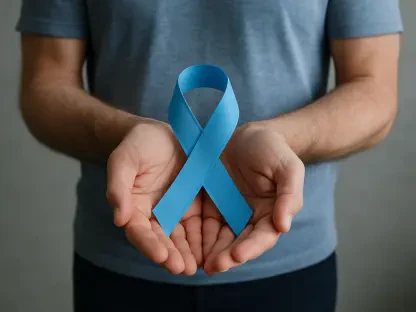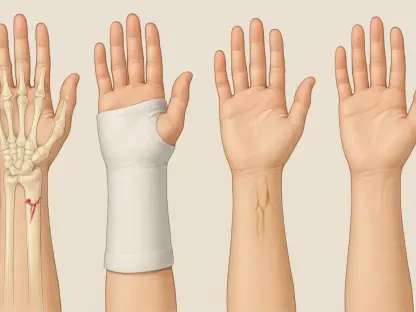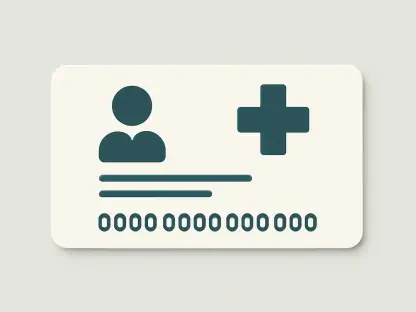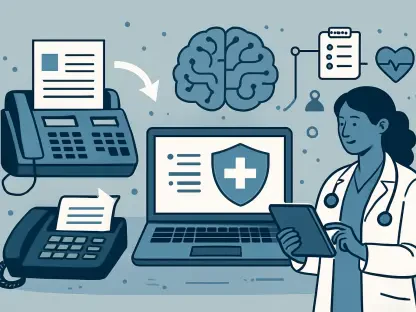Glaucoma, a devastating eye condition that ranks as a leading cause of blindness and affects over 4 million people in the United States, often disproportionately burdens older adults and specific racial groups, revealing significant disparities in care. A groundbreaking study published on October 6 in JAMA Ophthalmology has brought to light a critical factor influencing the care of those newly diagnosed with this condition: patient wealth. Conducted across the Sight Outcomes Research Collaborative (SOURCE) Consortium with data from over 1,400 patients, the research reveals stark disparities in healthcare outcomes tied to socioeconomic status. Co-authored by Dustin French, Ph.D., from Northwestern Medicine, the study analyzed key indicators such as intraocular pressure (IOP) reduction and adherence to follow-up care, painting a troubling picture of systemic barriers. Spanning data collected over more than a decade, the findings suggest that financial resources often dictate whether patients receive the standard of care necessary to manage this chronic condition effectively.
Beyond individual economic status, geographic location emerges as another significant hurdle. Patients residing in rural areas frequently struggle to attend follow-up appointments compared to those in urban settings, likely due to challenges in accessing specialized care or reliable transportation. These intertwined factors of wealth and location underscore how nonmedical elements can profoundly influence health outcomes for a disease requiring consistent monitoring. The study’s insights challenge long-held assumptions about disparities in healthcare, shifting the focus toward actionable solutions to bridge these gaps. As the numbers reveal, of the 1,030 patients with follow-up evaluations, 76% achieved the critical 15% IOP reduction in at least one eye within 12 to 18 months of diagnosis, yet those with lower wealth faced dramatically worse odds. This disparity highlights an urgent need to address the root causes of unequal access to life-changing treatments.
Understanding the Disparities in Glaucoma Care
Wealth as the Primary Barrier
The correlation between patient wealth and the quality of glaucoma care stands out as a central finding in the recent research. Patients with lower financial resources were found to be five to nine times less likely to achieve the recommended 15% reduction in intraocular pressure, a benchmark for effective management often reached through medicated eye drops or surgical interventions. This alarming statistic points to significant barriers in accessing timely treatments, as economic constraints frequently limit the ability to afford necessary medications or procedures. For many, the cost of care becomes an insurmountable obstacle, leading to delayed interventions that can worsen vision loss over time. The study’s data underscores that financial hardship creates a ripple effect, impacting not just immediate treatment but long-term health outcomes for those battling this chronic condition.
Moreover, the likelihood of being lost to follow-up care was 61% higher among patients with limited wealth. This gap suggests that economic challenges often deter individuals from maintaining regular contact with healthcare providers, a vital aspect of managing glaucoma to prevent irreversible damage. The inability to afford travel to appointments or take time off work for medical visits exacerbates the risk of falling through the cracks of the healthcare system. Unlike their wealthier counterparts, who can more readily access consistent care, these patients face a vicious cycle where financial strain directly contributes to deteriorating eye health. Addressing this disparity requires a deeper understanding of how socioeconomic status shapes engagement with medical services and a commitment to removing financial barriers that hinder effective treatment.
Geographic Challenges
Geographic location adds another layer of complexity to the disparities in glaucoma care, particularly for those in rural communities. Patients residing outside urban centers often face significant difficulties in attending follow-up appointments, a critical component of managing a condition that demands ongoing monitoring. Limited access to specialized eye care providers, coupled with the lack of reliable transportation options, creates a formidable barrier to consistent treatment. The research highlights that rural patients are far more likely to miss scheduled visits compared to their urban counterparts, resulting in gaps in care that can lead to worsening outcomes. This geographic divide underscores the need for innovative approaches to ensure that distance does not equate to diminished health prospects.
Additionally, the intersection of rural residence with economic disadvantage often compounds the challenges faced by these patients. Many in remote areas not only struggle with the logistics of reaching healthcare facilities but also lack the financial means to cover associated costs, such as travel expenses or time away from work. The study suggests that these combined factors contribute to a higher risk of vision impairment among rural populations with lower wealth. Tackling this issue calls for targeted interventions that address both the physical and economic hurdles to accessing care. Whether through mobile clinics, telemedicine, or subsidized transportation, healthcare systems must adapt to meet the unique needs of those in underserved regions to prevent further inequities in glaucoma management.
Broader Implications and Systemic Issues
Socioeconomic Status Over Racial Factors
A striking revelation from the study shifts the traditional narrative surrounding health disparities in glaucoma care. While race has long been considered a primary predictor of poor health outcomes, the research indicates that wealth and income play a far more decisive role. As noted by Dustin French, this finding redirects attention to socioeconomic inequities as the underlying cause of many disparities previously attributed solely to racial or ethnic differences. The diverse patient pool, which included 3% Asian American, 32% Black, 7% Latinx, and 57% White individuals with an average age of 70, demonstrated that economic status cuts across demographic lines as the dominant factor influencing care quality. This insight challenges healthcare providers to rethink how resources are allocated and prioritized in addressing systemic gaps.
Furthermore, focusing on socioeconomic status over racial factors opens new avenues for understanding why certain groups experience higher rates of glaucoma-related impairment. Economic disadvantage often correlates with specific demographics, creating a complex web of barriers that extend beyond biology or genetics. The study’s emphasis on wealth as a key determinant suggests that interventions must target financial inequities to achieve meaningful progress in health outcomes. By recognizing that income levels shape access to essential treatments, policymakers and clinicians can develop strategies that address the root causes of disparity rather than surface-level indicators. This paradigm shift is crucial for creating a healthcare system that serves all patients equitably, regardless of background.
Risk of Vision Loss
The heightened risk of blindness or severe visual impairment among patients with lower wealth emerges as a critical concern in the research findings. Inconsistent access to care, often driven by financial limitations, means that many individuals miss out on timely interventions that could halt the progression of glaucoma. The inability to achieve the benchmark IOP reduction within the recommended timeframe places these patients at a significantly greater risk of irreversible damage to their vision. This outcome not only affects individual quality of life but also places additional strain on healthcare systems as untreated conditions lead to more severe complications over time. The urgency to address these gaps cannot be overstated, as delayed care translates directly into preventable loss of sight.
Equally concerning is the long-term impact of being lost to follow-up, a trend more pronounced among economically disadvantaged groups. Without regular monitoring, subtle changes in eye pressure or optic nerve health can go undetected, accelerating the path to blindness. The study reveals that patients who fall out of the care system are often those least equipped to navigate financial or logistical barriers, perpetuating a cycle of neglect and worsening health. This disparity highlights the need for proactive measures to keep vulnerable populations engaged in treatment plans. Whether through community outreach or policy changes, ensuring that no patient is left behind due to economic hardship remains a pressing priority for reducing the burden of vision loss in society.
Potential Solutions and Future Directions
Tailored Interventions
In response to the glaring disparities uncovered by the study, researchers advocate for clinicians to take patients’ financial circumstances into account when designing treatment plans. Tailored interventions that consider economic barriers can make a significant difference in ensuring that all individuals receive the care they need to manage glaucoma effectively. For instance, offering subsidized medications or flexible payment options for surgeries could alleviate the burden on those with limited resources. Additionally, healthcare providers might prioritize education on low-cost alternatives or connect patients with support programs to bridge financial gaps. By personalizing approaches to fit individual needs, the medical community can help level the playing field and improve outcomes for economically disadvantaged patients.
Beyond individual adjustments, systemic changes within healthcare institutions are essential to support tailored care. The study suggests that insurance providers and policymakers should work collaboratively to facilitate access to IOP-lowering treatments and consistent follow-up care in line with established guidelines. This could involve expanding coverage for essential services or implementing community-based programs that target at-risk populations. Such efforts would ensure that financial constraints do not dictate the quality of care received. Emphasizing personalized strategies not only addresses immediate barriers but also builds trust between patients and providers, fostering long-term engagement in managing a chronic condition like glaucoma. The path forward lies in creating a system that adapts to the diverse realities of patient circumstances.
Technological Innovations
One promising avenue proposed by the study involves leveraging technology to bridge gaps in glaucoma care delivery. AI-driven models could be used to identify patients at higher risk of poor outcomes based on wealth metrics and other socioeconomic indicators. By flagging these individuals, healthcare systems can send targeted reminders for appointments or follow-up care, increasing the likelihood of adherence to treatment protocols. This proactive approach, as highlighted by Dustin French, focuses on dedicating extra effort to ensure that vulnerable patients remain engaged with their providers. Technology offers a scalable solution to address disparities, potentially transforming how care is prioritized and delivered to those who need it most.
Moreover, integrating technological innovations extends beyond reminders to include telemedicine platforms that bring specialized care to remote or underserved areas. For rural patients, virtual consultations can reduce the need for long-distance travel, making it easier to maintain regular contact with eye care professionals. Combining AI tools with telehealth services could create a robust safety net, catching early signs of disengagement before they lead to serious health consequences. The study’s call for such advancements reflects a forward-thinking mindset, recognizing that modern tools can play a pivotal role in dismantling barriers tied to wealth and location. As these technologies evolve, their implementation could mark a significant step toward equitable healthcare access for all glaucoma patients.
Building a Path to Equity
Reflecting on the comprehensive findings from the JAMA Ophthalmology study, it becomes evident that patient wealth has a profound influence on the quality of glaucoma care across diverse populations. The research, conducted through the SOURCE Consortium, revealed that economically disadvantaged patients faced substantial hurdles in achieving critical IOP reductions and maintaining follow-up care, with rural residents encountering additional obstacles. These insights paint a clear picture of systemic inequities that have long hindered effective treatment for many. By uncovering wealth as a dominant factor over race, the study reshapes the understanding of health disparities and emphasizes the need for focused action.
Looking ahead, the path to equity in glaucoma care hinges on implementing innovative strategies and fostering collaboration across healthcare sectors. Developing policies that subsidize treatments for low-income patients, expanding telehealth access for rural communities, and integrating AI-driven outreach to prevent loss to follow-up stand as actionable next steps. These measures, inspired by the study’s recommendations, offer a blueprint for reducing disparities and ensuring that financial status no longer dictates health outcomes. The challenge now lies in mobilizing resources and commitment to turn these insights into tangible improvements, paving the way for a future where every patient has an equal chance to preserve their vision.









